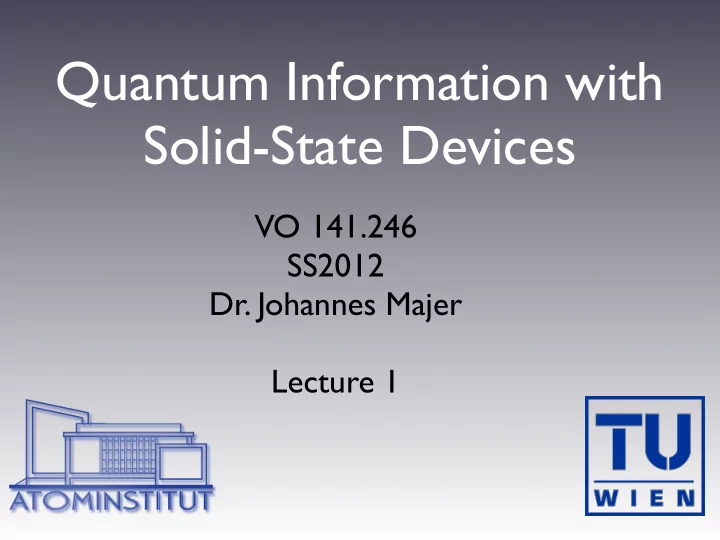

Quantum Information with Solid-State Devices VO 141.246 SS2012 Dr. Johannes Majer Lecture 1
Overview • Administration • Motivation • Subjects covered in the Lecture • History
Administration • Goal get you to the actual research frontier • Place & Time Fachgruppenraum, Freihaus Monday 15:00-17:00 no class next monday 19.3.2012 next class 26.3.2012 • Website & Communication http://majer.ch/qiss tiss johannes.majer@tuwien.ac.at • Literature & Further Reading website end of lecture
Administration • Homework Problems Purpose: review the material covered in the lecture enter your name in the list, if you have done it we randomly pick somebody to explain the solution 1 point for a entry in the list, extra point for a good presentation 75% of the possible points for a mark 1 in the first part of the exam making mistakes is not a problem • Exam 1st part if not fulfilled with the homework problems read and present an actual research paper
Administration • Material Website: Slides & Handnotes Problem Sets & Solutions Extra material
Moore’s Law quantum regime number of transistors doubles every 2 years Gorden Moore 1965
Information & Physics information processing is a physical process input physical object 1 0 1 1 0 physical process computation physical object 0 1 1 0 1 output information is physical Rolf Landauer
Quantum Information the fundamental laws of physics is quantum mechanics therefore the fundamental laws of information processing is quantum David Deutsch mechanics Quantum Information can we make use of quantum mechanics to speed up information processing?
Realization Ion Trap nuclear magnetic resonance NMR Photons Zuse Z1, 1936
Realization fundamental question is there a fundamental limit for the size of a quantum system? can we see quantum effects in a solid-state environment make use of nano-lithography with billions of electrons/ quantum chip nuclei? macroscopic quantum coherence
Energy Scales E = hc E = h ν λ microwave photons optical (red) photons
I Basic Concepts qubit/quantum bit Bloch sphere Rabi oscillation open quantum systems density matrix decoherence/dephasing Lindblad equation Ramsey oscillation echo techniques
I Basic Concepts multiple qubits qubit coupling / qubit interaction quantum gates simple quantum algorithms Deutsch-Josza algorithm Grover search algorithm state tomography DiVincenzo criteria
II Superconducting Electronics Josephson junction superconductors tunnel junctions Josephson equations SQUID
II Superconducting Electronics single electron transistor charging energy Coulomb blockade amplifying quantum signals
II Superconducting Electronics Quantum Circuits Circuit Elements C g charge and phase are V g conjugate variables quantization of a circuit
II Superconducting Electronics Superconducting Qubits Superconducting Qubits Charge Qubit Flux Qubit Phase Qubit
II Superconducting Electronics Qubit Measurement Qubit (avoiding) Decoherence Transmon Qubit
II Superconducting Electronics Transmission Line Resonators Z0 C in C out 1 2 L
II Superconducting Electronics circuit cavity QED Jaynes-Cummings hamiltonian vacuum Rabi oscillations dispersive regime
III Other Solid-State Quantum Systems Nitrogen Vacancy Color Center room temperature optically detected magnetic resonance (ODMR) coupling to N nucleus / 13 C nucleus
III Other Solid-State Quantum Systems Semiconductor Quantum Dots Loss-DiVincenzo proposal
Quantum Physics Planck: 1900 1900 1913 Bohr: model of the atom 1926 Schrödinger/Heisenberg 1935 Einstein/Podolski/Rosen 1963 Bell: inequalities 2000
Quantum Computing 1982 R. Feynman Quantum Simulations Quantum Information Processing 1985 D. Deutsch Deutsch algorithm 1994 P . Shor Prime factorization 1995 P . Shor Quantum Error Correction 1996 L. Grover Search in unstructured database
Problem Set Problem Set 1 - LV 141.246 QISS - 14.10.2011 1. Energy Scales As discussed in the lecture, you can convert energy into tempera- ture, frequency and wavelength via the following relations = E k B T = E hf c = λ f Calculate the corresponding values for the following data (a) Optical light (HeNe laser, red, 632.8nm) (b) WLAN frequency (2.4 GHz) (c) Ambient temperature (300 Kelvin) (d) Ionization energy (He ionization energy 24.58eV) Consider your results!
Problem Set 2. MATLAB - Getting Started MATLAB is very useful tool for dealing with nu- merical problems, especially handling vectors and matrices. It should be instal- led on your student computer. You can also purchase it for e 13.90 from the ZID http://www.sss.tuwien.ac.at/sss/mla/ (a) Create a vector t with values (0, 0.1, 0.2, ... 10). Calculate y = e t (3 i − 1 / 2) . Plot the real part of y versus t . (b) Enter the following three matrices 0 1 1 1 1 1 ✓ 0 0 1 0 1 0 ◆ B = 1 C = 1 1 − 1 1 − 1 i B C A = 1 0 − i √ @ A B C i 0 1 1 − 1 − 1 2 2 @ A 0 0 i 1 − 1 − 1 1 . Are these matrices hermitian (Hint: a matrix is hermitian if H = H † . Therefore calculate H − H † ), are they unitary? Calculate trace and eigenvalues of these matrices. search internet for: MATLAB tutorial
Recommend
More recommend